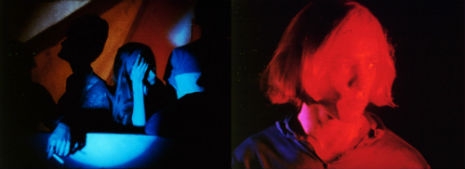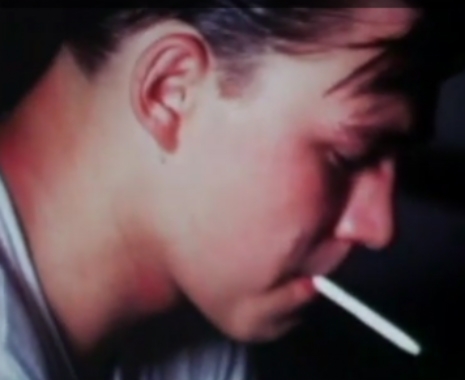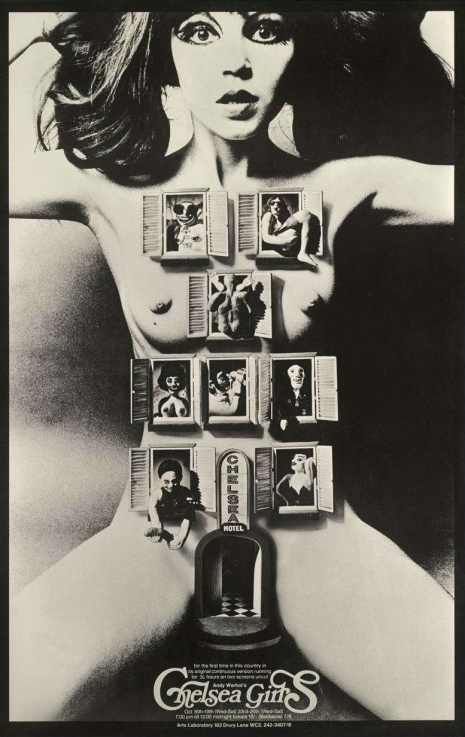
The iconic movie poster by famed illustrator Alan Aldridge. Warhol once remarked that he’d “wished the movie was as good as the poster.”
Chelsea Girls was Andy Warhol’s first “commercial” success as a filmmaker. Co-directed by Warhol and Paul Morrissey, the film consists of twelve improvised vignettes (two were semi-scripted by playwright Ronald Tavel) featuring the druggy, draggy, seemingly morally-bankrupt freaks who constituted Warhol’s entourage and inner circle.
The film was shot in summer and fall of 1966 in the Hotel Chelsea, at Warhol’s “Factory” studio and in the apartment where the Velvet Underground lived on 3rd Street. Brigid Berlin (“The Duchess”), Nico, Mario Montez, Ondine (“The Pope”), Ingrid Superstar, International Velvet, Rene Richard, Eric Emerson, Gerard Malanga, filmmaker Marie Menken, Ari Boulogne (Nico’s son), a gorgeous young Mary Woronov—who danced with the Velvet Underground as part of “The Exploding Plastic Inevitable”—and others are seen in the film’s three and a quarter-hour running time (the film unspooled on 12 separate reels). Most cast members are listed by their own names as they were essentially playing themselves.
Chelsea Girls was booked into a prestigious 600 seat uptown cinema in New York and actually distributed to movie theaters across the country. In 1966, it’s unlikely that middle America had any idea that people like this even existed. Film-goers in Los Angeles, Dallas, Washington, San Diego and yes, even, Kansas City probably got their first exposure to actual drug addicts, yammering speed-freak narcissists, homosexuals, drag queens and a dominatrix when they watched Chelsea Girls. To Warhol’s delight, the film was even raided by the vice squad in Boston. The theater manager was arrested and later fined $2000 when a judge found him guilty of four charges of obscenity.
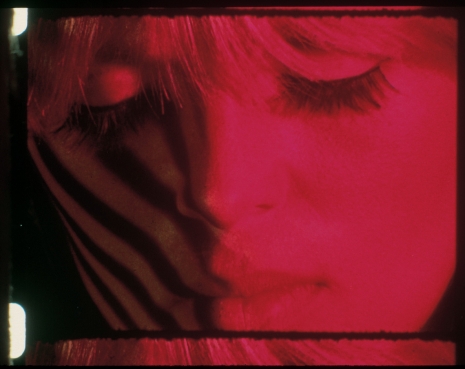
Movie critic Rex Reed said “Chelsea Girls is a three and a half hour cesspool of vulgarity and talentless confusion which is about as interesting as the inside of a toilet bowl.”
Tell us how you really feel, Rex!
The film was presented as a split screen, running simultaneously on two projectors (examples below) with alternating soundtracks. It was a mixture of B&W and color footage. Edie Sedgwick’s vignette was removed from Chelsea Girls at her insistence, but was later known as “The Apartment” or “Afternoon.” A section originally screened with Chelsea Girls called “The Closet” (about two “children” who lived in one, with Nico and Randy Bourscheidt) was cut and later shown as a separate film.
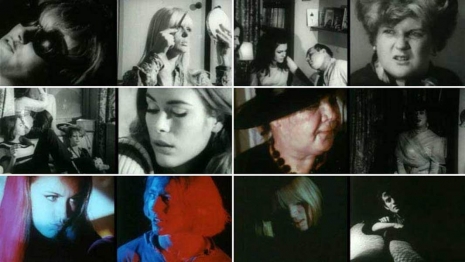
A young Roger Ebert reviewed it for The Chicago Sun-Times:
For what we have here is 3 1/2 hours of split-screen improvisation poorly photographed, hardly edited at all, employing perversion and sensation like chili sauce to disguise the aroma of the meal. Warhol has nothing to say and no technique to say it with. He simply wants to make movies, and he does: hours and hours of them. If “Chelsea Girls” had been the work of Joe Schultz of Chicago, even Warhol might have found it merely pathetic.
The key to understanding “Chelsea Girls,” and so many other products of the New York underground, is to realize that it depends upon a cult for its initial acceptance, and upon a great many provincial cult-aspirers for its commercial appeal. Because Warhol has become a social lion and the darling of the fashionable magazines, there are a great many otherwise sensible people in New York who are hesitant to bring their critical taste to bear upon his work. They make allowances for Andy that they wouldn’t make for just anybody, because Andy has his own bag and they don’t understand it but they think they should.

Ebert hits the nail squarely on the head. Chelsea Girls is actually a fucking terrible “movie.” If you view it as “art” or as an important cultural artifact of the Sixties (it’s both) or even as a historical antecedent to Keeping Up with the Kardashians, then you can give it a pass, and probably should, but if you’re expecting to be “entertained,” well, hold on, you’ll need to recalibrate your expectations. Only a few parts of the film are actually engaging (Ondine’s speed-freak monologues; Brigid Berlin poking herself with speed; the “Hanoi Hannah” section with Mary Woronov) the rest of it is… boring.
It looks good and parts of it are “interesting” because you can only hear what’s happening on one side of the split screen and so the silent side becomes somehow more intriguing, but, oh yeah, this is a boring thing to watch. It’s still very cool, but it’s still very boring, if that makes any sense.
Chelsea Girls used to be next to impossible to see since its original release—at least until it got uploaded to YouTube—usually screening just a few times a year around the globe. I caught it myself in the (appropriately) sleazy surroundings of London’s legendary Scala Cinema in 1984. There were probably six people there, including me. I admit to falling asleep for a bit of it, but I think everyone probably does. Thank god that was when you could still smoke in movie theaters!

Pssst, don’t tell anyone I told you this, but the entire film can be seen here. Probably the best way to watch it is to hook your computer up to your flat screen and do something else, sort of half paying attention—maybe clean?—while Chelsea Girls is on in the background.







